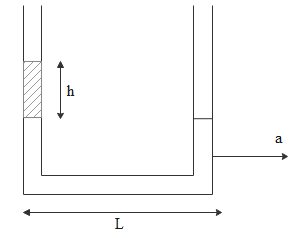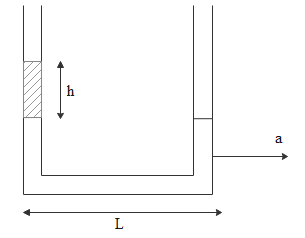Answer
414.9k+ views
Hint: It is known fact that the liquid has some mass. Now due to that mass there will be weight and pressure acting at every point of the liquid. If the liquid is in static condition then the pressure at points of same height level will be the same for the liquid of same density and different pressures can’t exist for one point. By using this property we will solve this question
Formula used:
$p = \rho {a_{eff}}{x_{eff}}$
Complete answer:
The basic property of any liquid in static condition is it will align its surface perpendicular to the net force. Let us take the example of a liquid in the beaker. The force acting will be its weight and it will be acting vertically downward. Now the surface will be horizontal i.e perpendicular to the net force.
If the surface is not perpendicular then the liquid will be having acceleration along the direction of force and liquid will no longer be in equilibrium.

If we consider the point which is exactly ‘h’ distance down to the top surface of the left limb, the vertical pressure due to gravity will be $p = \rho {a_{eff}}{x_{eff}}$
Along the vertical effective acceleration is acceleration due to gravity i.e ‘g’ and effective ‘x’ is ‘h’
$p = \rho {a_{eff}}{x_{eff}}$
$ \Rightarrow p = \rho gh$
the horizontal pressure due to pseudo acceleration ‘a’ will be $p = \rho {a_{eff}}{x_{eff}}$
Along the horizontal effective acceleration is acceleration due to pseudo force i.e ‘a’ and effective ‘x’ is ‘L’
$p = \rho {a_{eff}}{x_{eff}}$
$ \Rightarrow p = \rho aL$
Since two different pressures can’t exist for the same point of the liquid, equate the horizontal pressure to the vertical pressure. Then we will get
$\eqalign{
& \rho gh = \rho aL \cr
& \Rightarrow h = \dfrac{{aL}}{g} \cr} $
So, the correct answer is “Option D”.
Note:
The resultant force will be the resultant of weight and the pseudo force and the surface of the liquid will be perpendicular to the resultant force vector. We can solve the same problem by assuming liquid is in a beaker and moves with the same acceleration and then also we would get the same answer.
Formula used:
$p = \rho {a_{eff}}{x_{eff}}$
Complete answer:
The basic property of any liquid in static condition is it will align its surface perpendicular to the net force. Let us take the example of a liquid in the beaker. The force acting will be its weight and it will be acting vertically downward. Now the surface will be horizontal i.e perpendicular to the net force.
If the surface is not perpendicular then the liquid will be having acceleration along the direction of force and liquid will no longer be in equilibrium.

If we consider the point which is exactly ‘h’ distance down to the top surface of the left limb, the vertical pressure due to gravity will be $p = \rho {a_{eff}}{x_{eff}}$
Along the vertical effective acceleration is acceleration due to gravity i.e ‘g’ and effective ‘x’ is ‘h’
$p = \rho {a_{eff}}{x_{eff}}$
$ \Rightarrow p = \rho gh$
the horizontal pressure due to pseudo acceleration ‘a’ will be $p = \rho {a_{eff}}{x_{eff}}$
Along the horizontal effective acceleration is acceleration due to pseudo force i.e ‘a’ and effective ‘x’ is ‘L’
$p = \rho {a_{eff}}{x_{eff}}$
$ \Rightarrow p = \rho aL$
Since two different pressures can’t exist for the same point of the liquid, equate the horizontal pressure to the vertical pressure. Then we will get
$\eqalign{
& \rho gh = \rho aL \cr
& \Rightarrow h = \dfrac{{aL}}{g} \cr} $
So, the correct answer is “Option D”.
Note:
The resultant force will be the resultant of weight and the pseudo force and the surface of the liquid will be perpendicular to the resultant force vector. We can solve the same problem by assuming liquid is in a beaker and moves with the same acceleration and then also we would get the same answer.
Recently Updated Pages
How many sigma and pi bonds are present in HCequiv class 11 chemistry CBSE

Why Are Noble Gases NonReactive class 11 chemistry CBSE

Let X and Y be the sets of all positive divisors of class 11 maths CBSE

Let x and y be 2 real numbers which satisfy the equations class 11 maths CBSE

Let x 4log 2sqrt 9k 1 + 7 and y dfrac132log 2sqrt5 class 11 maths CBSE

Let x22ax+b20 and x22bx+a20 be two equations Then the class 11 maths CBSE

Trending doubts
Fill the blanks with the suitable prepositions 1 The class 9 english CBSE

At which age domestication of animals started A Neolithic class 11 social science CBSE

Which are the Top 10 Largest Countries of the World?

Give 10 examples for herbs , shrubs , climbers , creepers

Difference between Prokaryotic cell and Eukaryotic class 11 biology CBSE

Difference Between Plant Cell and Animal Cell

Write a letter to the principal requesting him to grant class 10 english CBSE

Change the following sentences into negative and interrogative class 10 english CBSE

Fill in the blanks A 1 lakh ten thousand B 1 million class 9 maths CBSE




